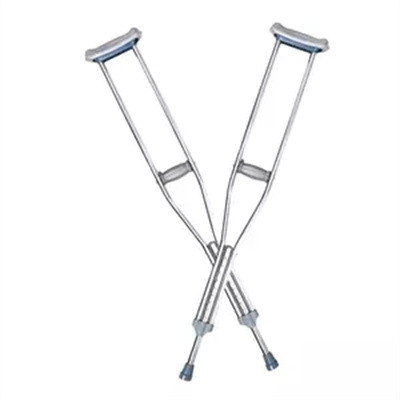Exercising while using crutches can be a challenge, but it’s essential to maintain your strength, flexibility, and overall well-being during your recovery. Always consult with your healthcare provider or physical therapist before starting any exercise program while using crutches. Here are some tips for exercising safely with crutches:
- Consult Your Healthcare Provider: Speak with your healthcare provider or physical therapist to ensure you are medically cleared for exercise and to receive specific recommendations tailored to your condition and limitations.
- Warm-Up and Cool Down: Prior to exercising, perform a gentle warm-up to increase blood flow to your muscles and prepare your body. Afterward, cool down with gentle stretches to prevent muscle stiffness.
- Low-Impact Activities: Focus on low-impact exercises that are easy on your joints. Examples include seated leg lifts, seated arm exercises, and gentle range-of-motion movements.
- Core Strengthening: While sitting or lying down, perform core-strengthening exercises like pelvic tilts, abdominal contractions, and leg raises. A strong core can improve your stability and balance on crutches.
- Upper Body Strength: Since you’ll be relying on your upper body for support on crutches, focus on exercises that strengthen your arms, shoulders, and back. This can include resistance band exercises, seated dumbbell curls, and seated shoulder presses.
- Balance and Stability: Balance exercises can be particularly helpful. Practice standing on one leg (if possible) while holding onto a sturdy surface for support. As you progress, try to stand on one leg without support for short durations.
- Seated Cardiovascular Exercise: Consider seated exercises that can elevate your heart rate, such as seated leg cycling or upper body ergometer (UBE) exercises. These can help improve cardiovascular fitness without putting weight on your legs.
- Breathing and Relaxation: Incorporate deep breathing and relaxation exercises to reduce stress and anxiety, which can be common during recovery. Stress reduction is essential for overall well-being.
- Safety First: Exercise in a safe environment, free from tripping hazards. Have someone nearby, such as a family member or friend, while you exercise for added safety.
- Progress Gradually: Start with low-intensity exercises and gradually increase the duration and intensity as your strength and mobility improve. Avoid overexertion.
- Modify Exercises: Adapt exercises to your current abilities and limitations. If a particular movement is painful or challenging, modify it or skip it until you can do it comfortably.
- Stay Hydrated: Drink plenty of water during and after your exercise sessions to stay hydrated, especially if you’re working up a sweat.
- Listen to Your Body: Pay attention to any pain or discomfort while exercising. If you experience pain that goes beyond the usual discomfort associated with exercise, stop and consult your healthcare provider.
- Rest and Recovery: Give your body adequate time to rest and recover between exercise sessions. This allows your muscles to heal and rebuild.
- Stay Positive: Maintaining a positive attitude can make a significant difference in your recovery. Celebrate your progress, no matter how small it may seem.
Remember that your exercise program should be tailored to your specific needs and abilities. It’s crucial to work closely with your healthcare provider or physical therapist to design a safe and effective exercise plan that supports your recovery while using crutches.




















